Urban Farm Design with Scott Murray
Interview with Scott Murray at Edge of Urban Farm on Urban Farm Design
We’re on our Edge of Urban Farm in Vista, California and it’s a 1.2 acre site that we’ve developed about three-quarters of an acre as a micro farm. And at times, we’ve run a CSA here where we fed 18 families off of this space.
Right now, it’s got a very little bit of cultivation going on it because our drought water cutbacks are so severe that we felt that it was easier to not fight it.
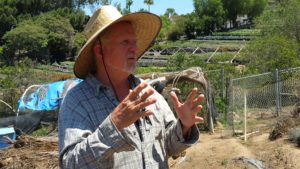 How long have you been gardening on slope?
How long have you been gardening on slope?
So this is our seventh year, we moved in and developed the farm. It took me a year to do that and so we got planted half way through the first year. And then we progressed all the way down the hill, so when we walk through the farm, you’ll see that there’s five sections and they taper. And there are a number of features built into the farm that are sustainability features like water harvesting swales.
We have a composting area and we have trees that change the bio zones of the property. So we have a variety of bio zones going on, it’s a very diverse environment considering how small it is.
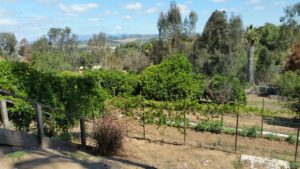 What got you interested in urban farm design?
What got you interested in urban farm design?
My mom, when I was about ten years old, in Marin County in Northern California. We had a garden in our backyard. She had lived through the depression in Salt Lake City on a two-acre corner lot. And that lot is what kept their family alive, and a number of neighborhood families because families would volunteer to work in their garden to take home food. So, my mom has a real core value of learning how to grow your own and we did that in our own backyard. And that got me interested in what the flavor of real vegetables is like, like the tomato that just came off of a plant.
The Future of the American Agriculture System
Then, I went to college and I can remember having to write a paper…I wanted to have a salad and I went shopping. And the produce was so bad and ugly and beat up that I got the subject for my paper which was the future of the American agriculture system. And back in those days, the 1970s, we had an average of 120 produce items in a produce department. You got four apples, you didn’t get 20 types of apples, you got four lettuces. Now we have an average of 600 items in a produce environment.
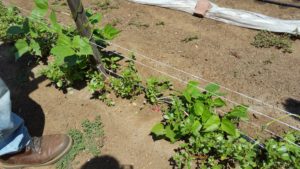 And so, I got interested in urban farming because I wanted to farm and I couldn’t afford a big farm. So the learning pathway is to make a small space very productive.
And so, I got interested in urban farming because I wanted to farm and I couldn’t afford a big farm. So the learning pathway is to make a small space very productive.
Urban Farm Design Strategy
And then if you have more space available you can develop a strategy, what I call a site specific strategy, that fits that space and allows you to optimize the production of that space and make a farm out of it.
How does someone develop a specific site strategy in their urban farm design?
Well, basically, with a blank piece of paper and a potential site that they know the boundaries of, you start by mapping, simple perimeter map and then you look at what features do you have. On an urban farm you’d be hoping that there was a water faucet on that property and that you had a water meter on that property.
 Or if you’re really, really lucky you’d have like in Phoenix ditch water or a well, so you had a secure water source. Then you would assess the soil. Are you on a hillside, are you on flat ground, are you on rolling ground? How could we lay out a farm on this?
Or if you’re really, really lucky you’d have like in Phoenix ditch water or a well, so you had a secure water source. Then you would assess the soil. Are you on a hillside, are you on flat ground, are you on rolling ground? How could we lay out a farm on this?
Include Walkways in an Urban Farm Design
And one of the most important things I learned is, my first big farm acre, I was so eager to farm every square inch of it that I didn’t leave big enough walkways at the ends of the beds. It was enough room to get through, as my mom taught me, Indian style one foot in front of the other.
But when you had to come back with a wheelbarrow and put more compost in or take out plants, it was like ugh, and so one of the things is visualizing what that garden looks like when it’s fully active. And each site pretty much is different. You could have a big 40-acre parcel that is flat and pretty much the same soil and make 40 one-acre farms out of it, but that would be very unusual.
Where to Find Land for a Farm
Normally, like where we are is on the edge of a city with a population of about 75,000. And we’re in one of the older districts of the city. So there are big lots of different sizes. Like we have a 1.2-acre lot. We look right over here, and there’s some folks that have their house on maybe a quarter acre, and have an acre or two, or we have one that’s almost seven acres that’s kind of a pocket of space that’s abandoned by the development.
 In modern development, they don’t waste any of that space. They look at how many homes can we jam into this space, and the yards are much smaller. So I always recommend that people look in older neighborhoods and out on the edges as the city grew early on there will be bigger lots. As the city grows now, development makes for very small spaces to farm.
In modern development, they don’t waste any of that space. They look at how many homes can we jam into this space, and the yards are much smaller. So I always recommend that people look in older neighborhoods and out on the edges as the city grew early on there will be bigger lots. As the city grows now, development makes for very small spaces to farm.
Creative Urban Farm Design with Limited Land
I met one person a couple of years ago who found an eighth of an acre to farm up in New Port Beach by looking at Google Earth and finding the biggest backyard that had nothing going on in it. And then he went over and knocked on their front door and said, how about if I farm your backyard?
[LAUGH], That’s creative. So, he took using a tool that’s available to us all, he located the spot close to his home.
Profitable Urban Farm Design on Micro Parcels
Another example of site specific is a young woman that I met in Salt Lake City. And she had gone four years of college, spent a whole year looking for work, could not find any work. Spent her spare time hanging out at the farmer’s market because she could trade a little bit of work for food.
She realized that she wanted to be a farmer, so she found in her neighborhood in the avenues in Salt Lake. Her first year she farmed two acres that was made up of seven backyards. And in the first year she made enough money in the growing season to survive.
 And the next year she expanded to four acres and six employees. Now, seven years on, she farms almost ten acres in the neighborhood in backyard patches, and has a staff of about 12 people working for her. Does CSAs and farmer’s markets and sells to restaurants and to Whole Foods stores. And there is no farm.
And the next year she expanded to four acres and six employees. Now, seven years on, she farms almost ten acres in the neighborhood in backyard patches, and has a staff of about 12 people working for her. Does CSAs and farmer’s markets and sells to restaurants and to Whole Foods stores. And there is no farm.
It’s all little microchip-type patches. And her staff has these three wheel cargo bikes, cuz it’s pretty flat. So they ride from garden to garden, most of the time not even using a vehicle.
Wow, that’s a creative solution, to be able to grow.
Right.
Why did you pick a piece of property that was so slanted and what have you done in your urban farm design to do make use of this property and actually turn that slope into an asset?
The first thing is you often can’t select the perfect place. Like this location faces north and it’s a hillside facing north. So in the wintertime, we lose a lot of sun. Ideally we’d be facing south, where we had added sun in the wintertime because of the angle of the slope.
So we started off with disadvantages. But that dog that’s been coming around our feet here, Bandit. He’s actually the reason we’re at this house. Because my middle son wanted a dog and for years three kids was like enough pets. You know? We don’t need more mouths to feed.
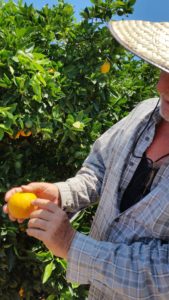 And finally it was getting to the point where we got to let him have his dog, and this amazing dog was given to him. It was okay with our landlord at the time. But then, he subdivided his house and got in a tenant that slept during the daytime. And the dog barks. He’s a dog. And so one day, the landlord came to our door, pounding on our door, and, you know, your dog has to go. Either the dog goes or you guys go. It was like well now, you’re telling me take my child’s, many years where he pined to have a pet, and now you want me to take it away from him?
And finally it was getting to the point where we got to let him have his dog, and this amazing dog was given to him. It was okay with our landlord at the time. But then, he subdivided his house and got in a tenant that slept during the daytime. And the dog barks. He’s a dog. And so one day, the landlord came to our door, pounding on our door, and, you know, your dog has to go. Either the dog goes or you guys go. It was like well now, you’re telling me take my child’s, many years where he pined to have a pet, and now you want me to take it away from him?
No, looks like we’re going.
So we got on the Internet and Craigslist and started looking at houses available to rent. We actually found this place and we came over and looked at it at night and we saw that there was a good sized backyard. That it was kind of a cul-de-sac, a private neighborhood.
Good Landlords Make a Difference
We felt we could make this work, and found landlords that would allow us to develop it as a farm, and have animals. At the time, we had two goats and 20 chickens. The goats ate everything on the property in the first two months. Which was good in some ways and bad in others because I thought my wife pruned her roses and she said, no. And I looked out and the goat was eating them down, chomp, chomp, chomp. And the boys had gotten the goats as a project to do fire clearing, you know? Overgrown brush for clearing back.
Adaptive Urban Farm Design
So we’ve adapted the property to suit our needs. We’ve done some terracing; we’ve done bed building. We have pathways and walkways. We’ve made it as efficient as possible, but also allowed for a truck to be able to be brought all the way in to the bottom of the property and dump a load of compost, or cut a dead tree.
We’ve learned from years of experience that you need access because you’re creating a lot of heavy stuff really when you’re growing food. You’re creating heavy food, like picking tomatoes on 120-foot-long row. You start in the middle and pick to the end.
And you have to think through all these things to build. Any farm, but especially in urban farm.
 How much production do you get out of this property in a years’ time?
How much production do you get out of this property in a years’ time?
Well, weight wise, we’ve never really kept track of the weight. We farmed three quarters of an acre. Some years our total income off that three quarters of an acre was close to $35,000. So that was pretty good considering that we farm part time. And it’s a supplemental part of our income, not the core part of our income. We used to farm previous to this we were on a three quarter acre site, we farmed a half acre. We were growing culinary herbs for shipment to Chicago. And we actually made close to $40,000 a year on a half-acre. That was probably 60% of our income, so we had more time for it.
So it varies and keeping records is really an important thing that’s hard to do.
Urban Farm Design and Development
So we’ve developed it over time. When we first started, the citrus trees were extraordinarily weak. You could see right through all of them because they only had about 25 to 30% of their leaves.
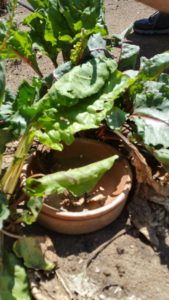 One tree had two leaves. We’d, maybe it was dead. Then we looked at it. No, it was alive. But we didn’t even know that it was a mandarin orange until it started to grow. But once we started giving it food and love, boom. We harvested, last year Off of our 15 citrus trees, two tons of organic citrus.
One tree had two leaves. We’d, maybe it was dead. Then we looked at it. No, it was alive. But we didn’t even know that it was a mandarin orange until it started to grow. But once we started giving it food and love, boom. We harvested, last year Off of our 15 citrus trees, two tons of organic citrus.
Scott’s Tips for Beginning Urban Farm Design
Well I think that the key for everybody is to start in steps. If you’re a backyard gardener, try doing four times the space in your backyard if it’s available, or finding another space. And grow in increments because there are a lot of complicated pieces, moving pieces to a farm. And it’s really good if your experience is pushing you up rather than you’re stretching up past your experience and hoping for the best. One of the key things to all farming is that the money you save is often the money you earn, that’s your real profit.
Economical Urban Farming Solutions
There’s a whole process of farming. We have our own small greenhouse on the front of the house, so we can make our own transplants. We do some of our own processing, we do our own packaging. But boxes, for example, new agricultural boxes can cost between $1.75 and $4.
Then you take and you ship it to a restaurant or a store. And they throw the box away. And if you can work with that store so that they’ll fold that box. Because about half of agricultural boxes are what are called folding boxes, and and about half are glued boxes. So they can fold that box flat and store it for you. You can get three, four, five uses out of it.
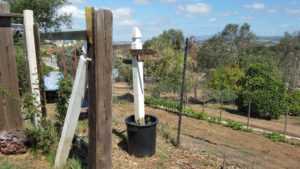 A Better Solution
A Better Solution
And we also use a lot of actual plastic bins, like Costco or Home Depot sells, that have folding tops. And you can fold the tops out and they’ll stack, nested. But if you fold the tops over, they’ll stack up. And we would get those for $5. Now, they’re more like $7. But we would get sometimes 35 or 40 uses out of that box. We’d line it with a plastic bag, pack it with produce, stack it up in our delivery vehicle. Take it to the customer, leave them with them and pick up the ones from our last shipment. And unless they got thrown around or dropped, they would last a long time. Though we have found boxes, we also painted, we silk screened our name on to them and we’d see those around. And then people would grab one. Oh, I need this! But largely we saved a fortune doing that.
The Value of Good Tools
And the other thing is when we start out, we have to buy cheap tools, and cheap tools are a cruel joke because they break (quickly.) Buying a $6 shovel is really good if you’re gonna have a group of volunteers working, because they’re going to break a $20 shovel as fast as they’d break a $6 shovel because they don’t know how to operate it. But if you’re buying it for yourself to last a long time, buy the better quality that you can afford.
And take care of it because it’s so nice to have a good tool in the garden versus a lousy tool in the garden. And that comes down to also equipment that you might buy. Raising a family as a farmer, my wife worked at home and home-schooled our kids, and she was an at home mom. And so it was one income and we had to be very clever but we always had food. So many years, many times we bought cheap weed-whackers for example, $120 and it would last one, maybe two seasons. Now I’ve got a really nice weed whacker I spent $400 on. And it’ll probably last me 20 years.
Urban Farm Design and Agribusiness
So it’s each piece of the puzzle becomes a very important piece of your business. This is a business. Even if you’re only growing 10 by 10 square feet. If you’re in a location where you can grow radishes, for example, and sell them to a street taco stand.
In some places in the third world people only have a tiny bit of space. But if they use it very efficiently, then they can go right outside their front door and have a customer, they have a business and they’re adding to their income. And then it grows from there.
 Greenhouses in Urban Farm Design
Greenhouses in Urban Farm Design
If you can, building a greenhouse will improve your production. On the half acre farm for our culinary herbs we made three tunnel greenhouses out of PVC pipes and greenhouse plastic and some wood for framing the ends. But those quadrupled the value of that space. And paid for themselves very quickly. Though they were not permanent structures. So they lasted five years. If you can afford a more expensive metal framed high tunnel greenhouse, that will add to your value. In the industry, they say that greenhouse space is ten times more productive than open space.
In Arizona, it might be a shade house in the summer time. You don’t need the extra heat, you actually need the shade. Here in California, having a greenhouse in winter allows us to grow. An unheated greenhouse just buttoned up we can grow tomatoes, peppers, eggplants like crazy.
In the colder climate, then they need to be heated and conditioned, or in a warmer climate they need to have good ventilation, But it’s pretty amazing what you can do.


